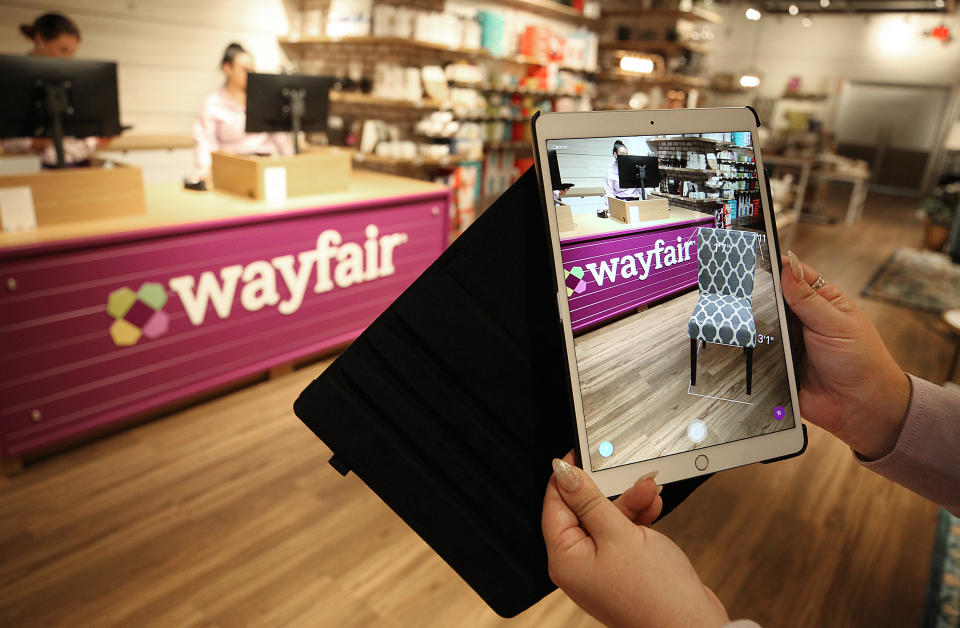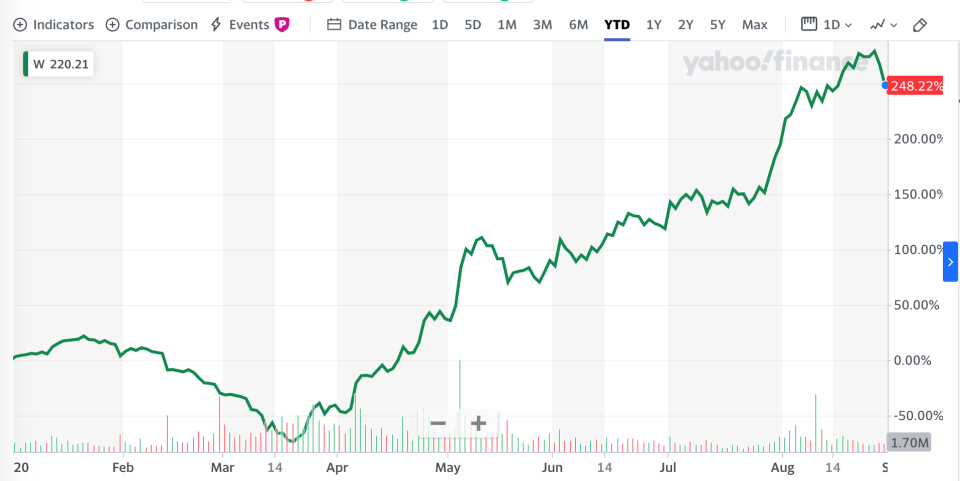Why Wayfair stock is up 250% this year
Wayfair stock (W) has been on a rocket ride since April, and hit a new 12-month high this week.
Shares of the online furniture retailer are up 37% in the past month and a staggering 250% for 2020 so far. On Aug. 5, the company posted a huge beat for its Q2 earnings, with revenue of $4.3 billion, up 85% from one year prior, and earnings of $3.13 per share after reporting a loss one year prior. Most importantly, Q2 was Wayfair’s first profitable quarter since before its 2014 IPO, and its first-ever quarter with double-digit positive EBITDA margins (10%).
Wayfair is benefiting from the obvious: Americans are buying everything online amid the coronavirus pandemic. Target said its online sales rose 195% in Q2; Walmart’s rose 97%; Dick’s Sporting Goods saw online sales spike 194%; Etsy’s sales rose 137%; Best Buy online sales rose 242%. All of these chains fueled the largest ever quarterly growth in U.S. e-commerce, up 44% in Q2 to 16.1% of total U.S. retail spending. One year ago, that figure was 10.8%.
But Wayfair may be the name that best represents a potential wrinkle in that e-commerce surge: Was it just a short-lived pandemic bump? An Aug. 14 report from S&P Global Market Intelligence ranked Wayfair as the No. 8 “most vulnerable public retailer.

Wayfair said on its earnings call that in Q2 the site welcomed nearly 5 million new customers more than in the last four quarters combined. It also welcomed back more than 1 million past customers who had not visited the site in over a year. Those are stunning figures. But the question is whether those customers will return, or did they just visit Wayfair as a one-off pandemic shopping experience.
CEO Niraj Shah addressed this directly: “What was even before COVID an inexorable shift to e-commerce then became supercharged over the last several months...and we believe much of the step change in online penetration will prove to be sticky. In fact, our view is that e-commerce adoption is likely to continue to shift faster than it did pre-COVID... These customers discovered why shopping at Wayfair can be a superior experience to shopping at brick-and-mortar.”

There’s another point Shah made on the earnings call that could be taken as positive or negative, depending on your long-term view for physical retail. Shah said the home goods category (Wayfair’s bread and butter) was particularly resilient during the pandemic because, “consumers de-prioritized expenses such as travel and entertainment, and shifted their focus and discretionary spending to their homes.”
In other words, Americans used quarantine to spiff up their home decor. That was great for Wayfair, but will it continue once the pandemic is quelled and people begin to fully re-emerge? If remote work is here to stay, even beyond the pandemic, then it stands to reason that people will continue to prioritize their home space. But not all companies have indicated they believe the office is dead: Blackstone, the private equity giant, is bringing its employees back to the office after Labor Day. And Amazon just bought new office space in six U.S. cities.
Regardless of what happens next for U.S. e-commerce trends, Wayfair’s stock market surge in 2020 is remarkable considering that just one year ago, the company was in the news because of a major employee walkout over politics.
—
Daniel Roberts is an editor-at-large at Yahoo Finance. Follow him on Twitter at @readDanwrite.
Read more:
Why Dick’s Sporting Goods is wildly outperforming amid the pandemic
Walmart and Target huge e-commerce gains are a blaring siren to brick-and-mortar retail
Amid pandemic, Walmart says it’s seeing increased sales of tops—but not bottoms
Companies like Nike and Dick’s are ‘finding their woke values’
Etsy CEO on huge Q2: Etsy is 'becoming much more mainstream'
Amazon tells employees to delete Tik Tok, then says email was ‘sent in error’
